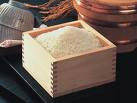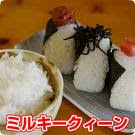[ . BACK to WORLDKIGO TOP . ]
::::::::::::::::::::::::::::::::::::::::::::::::::::::::::::::::::::::::::::::::::::::::::::::::::::
Rice, Reis, with many Japanese words
The Japanese Rice Culture -
die Reiskultur Japans.
Rice is the staple food of Japan.
There are many words for it, from the plant to the cooked product. Many of them are kigo.
Rice plant (ine 稲, sanae 早苗 )
Rice grains are called "kome, mai 米".
On the table and cooked, it is called
"Gohan" ご飯 or "meshi" 飯 めし.
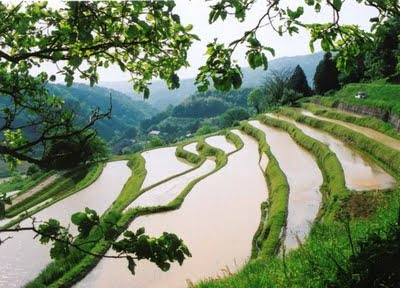 Tanada ... Terraced rice fields of my home in Ohaga
Gabi Greve, Japan
Tanada ... Terraced rice fields of my home in Ohaga
Gabi Greve, Japan
Japan is a rice-growing culture. It has many regional celebrations and rituals related to rice growing and harvesting.
Rice is traditionally much more than just food.
Please read this first and come back:
Japanese Rice Culture
by Nold Egenter
quote
Imperial Rituals in Japan
The Emperor, embodying the god of the ripened rice plant, plants the first rice of the spring and harvests rice from the plants of the autumn. In one of the most solemn Shinto ceremonies of the year the Emperor, acting as the country's chief Shinto priest, ritually sows rice in the royal rice paddy on the grounds of the Imperial Palace.
 The Great Food Offering
The Great Food Offering —in which the Emperor spends the night with the Sun Goddess as a dinner guest—is something every emperor is required to do shortly after ascending to the throne. First recorded in A.D. 712, the ritual takes place at night because the Sun Goddess is in the sky during the day.
The rite follows a ritual bath, symbolizing purification, and takes place in two simple huts, made of unpealed logs and lit with oil lamps, erected on the Imperial Palace ground in Tokyo. The huts are believed to represent the original first huts where Jimmu Tenno communed with the Sun Goddess.
During the Great Food Offering, the Emperor absorbs some of the Sun Goddess spirit and thus "becomes a kind of living ancestor of the entire Japanese family." The pre-World War II belief that the Emperor was a living god is based on this ritual.
Murray Sayle wrote in the New Yorker, "I witnessed the most recent Great Food Offering....from my position behind a police barrier a hundred yards away. During my chilly vigil, all I saw was a figure in white silk—presumably the Emperor—flitting from one small building to another. It took perhaps one second in all."
No one but the Emperor has ever witnessed the ceremony. According to a press release from the Imperial Household Agency, "
The new Emperor ... offers newly-harvested rice to the Imperial Ancestor [the Sun Goddess] and the deities of Heaven and Earth and then partakes of the rice himself, expresses gratitude to the Imperial Ancestor and these deities for peace and abundant harvests, and prays for the same on behalf of the country and people."
source : factsanddetails.com
A set of harvest festivals in November carried out at the imperial palace and shrines throughout the country:
. Niiname sai 新嘗祭
"Celebrations of the First Taste" .
November 23
. Inari 稲荷 Fox Deity, Rice Deity .
. Toyouke no Ookami 豊受大神
The Great Deity that gives Bountiful .
Deity of Rice and Food
. Akamai shinji 赤米神事 ritual of the red rice .
At Takuzutama Shrine 多久虫玉神社, Tsushima Island, Nagasaki
長崎県対馬市.
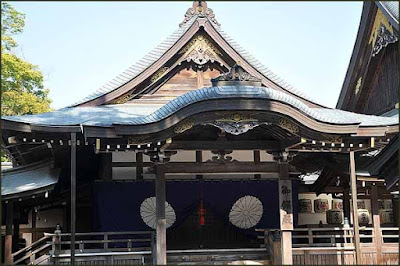 mikeden 御鐉殿(みけでん) "the sacred dining hall"
mikeden 御鐉殿(みけでん) "the sacred dining hall"
for the deities at Ise shrine.
quote
Higoto asayū ōmike sai
A celebration at the Grand Shrines of Ise (Ise Jingū) in which sacred food is offered twice daily, in the morning and evening, to Amaterasu Ōmikami and other deities.
Also referred to as the regular sacred offering (jōten mike), this celebration corresponds to the daily offering (Onikku) ceremony conducted at ordinary shrines. In response to a dream revelation from Amaterasu Ōmikami during Emperor Yūryaku's reign,
Toyouke Ōmikami was moved from Tanba Province to Ise Shrine as the tutelary deity of foodstuffs (miketsu kami).
Based on this lineage, kami seats (shinza) for Amaterasu Ōmikami, Toyouke Ōmikami, and a "deity enshrined on a subordinate altar in the same honden" (aidono no kami) are built in the
Outer Shrine's Sacred Dining Hall (Mikeden). The Mikeden has an ancient architectural style with "log storehouse" (ita azekura) wall construction and steps carved from a single piece of timber (kizami kizahashi).
This structure is also where members of
the Watarai priestly clan have traditionally served in such roles as senior priests (negi) reciting the norito or as children who observe votive abstinence and serve in ritual services (monoimi).
With the Meiji Restoration, shinza were added to auxiliary sanctuaries (betsugū) and senior priests, junior priests (gonnegi), and shrine administrators (gūshō) began serving inside the Mikeden. Although "Meiji-Period Rules for Ritual Procedures at Jingū" (Jingū Meiji saishiki) did not designate this ceremony as a matsuri, the later "Regulations on Ritual Observances at Jingū" (Jingū saishirei) positioned it as a lesser festival (chūsai) and named it Higotoasayū ōmikesai.
Whereas other Ōmike ceremonies take place in front of the main sanctuary (shōden) building, this celebration is unique because the deity is "worshipped at a distance" (yōhai) from inside the Mikeden.
source : Nakanishi Masayuki, 2006, Kokugakuin
 Shingu shinden 新宮神田 rice fields for the deities
Shingu shinden 新宮神田 rice fields for the deities
at Ise shrine. 神田(しんでん=神殿)
They are 3 hectar large.
. Ise Grand Shrine (伊勢神宮 .
. shinden 神田 - saiden 斎田 "divine rice field" .
. Hoozuki ichi 鬼燈市 lampion flower market .
shiman rokusen nichi 四万六千日
46000 days
Why 46000 days, you might ask?
This is supposed to be
the number of rice grains in one Japanese measure of rice, Japan being an old rice-growing nation and wasting even one grain of it was a big sin.
The
koku, kokudaka (石/石高) is a Japanese unit of volume, equal to ten cubic shaku. In this definition, 3.5937 koku equal one cubic metre, i.e. 1 koku is approximately 278.3 litres. The koku was originally defined as a quantity of rice, historically defined as enough rice to feed one person for one year (one
masu is enough rice to feed a person for one day).
A koku of rice weighs about 150 kilograms.
During the Edo period of Japanese history, each han (fiefdom) had an assessment of its wealth, and the koku was the unit of measurement.
© More in the WIKIPEDIA !
:::::::::::::::::::::::::::::::::::::::::::::::::::::::::::::::::::::::::::::::::::::::::::::::::::
Some vocabulary
chagayu 大和の茶がゆ rice gruel cooked with tea and
chahan 茶飯 / 大和茶飯 rice boiled with tea and soy beans
from Nara prefecture
daikon-meshi 大根飯 rice with radish
gekochter Reis mit geschnetzeltem Rettich
gohan no tomo ご飯の供 "friend of the cooked rice"
condiments and food you place on your rice bowl, for example furikake
. . . CLICK here for Photos !

gohan no tomo ご飯の友 "friend of cooked rice"
a spedial brand from Kumamoto. A kind of furikake, with various flavors.
shiso perilla, hijiki seaweed, spicy sesame, norigoma seaweed with sesame
御飯の友
 gyohan
gyohan 魚飯 "fish rice"
Special dish served for celebrations, especially along the Inland Sea and at Takehara. The rich owners of salt production fields served it to their visitors.
Various ingredients are finely shredded, the shrimp flavored with salt. The ingredients are served separately on a huge plate. Each visitor takes a bit of each on his bowl of rice, then plenty of dashi soup is added.
kama-meshi 釜飯 rice, meat, and vegetables boiled together in a small pot
Gericht, bei dem Reis mit den anderen Zutaten zusammen in einem kleinen Topf gedämpft wird
Reis und Beilagen im gleichen Topf gekocht
katemeshi かて めし (糅飯) rice mixed with vegetables, radish, seaweed or other ingredients to make it last longer in times of scarcity
gemischter Reis
kenmai 献米 rice offering
Reisopfer
. shinjin kyooshoku 神人共食
God and Man eating together .
shinsen 神饌 Shinto- Food offerings / Shinto-Speiseopfer
shinsenmai 神饌米 Reis als Speise-Opfergabe in Shinto-Zeremonien.
. . . CLICK here for Photos !
koge, o-koge, okoge, rice crust in the pot おこげ (御焦げ)
kogemeshi こげめしdishes with okoge
festgebackener Reis, angebrannter Reis am Topfboden
mochi もち (餅) pounded rice taffy
das Mochi; Reiskuchen
nuka ぬか (糠) rice bran
Reiskleie
ojiya, o-jiya おじや kind of rice gruel with miso base
The name comes from the sound of the slowly cooking broth, jiyajiya じやじや.
kigo for winter
dicke Reissuppe; (mit Miso oder Sojasoße gewürzt)
o-kayu, okayu, kayu 粥 rice gruel
Reissuppe; Reisgrütze
auch
ojiya genannt.
(nicht identisch mit dem in Deutschland als REISBREI bekannten Gericht mit Zimt und Zucker)
. . .
Chinowagayu, chinowa-gayu 茅の輪粥 rice porridge
chi no wa kayu, served on the last day of the sixth month.
kodaimai こだいまい 古代米 rice of old / my photo
rice from the time of the gods
genmai, gokoku mai
o-kowa, okowa おこわ (御強) "the honorable strong one"
mix of regular Japanese short grain rice and mochi-gome, sticky rice cooked with other ingredients.
kowameshi こわめし
Mochi-Klebreis mit roten Bohnen
Onigiri おにぎり rice balls
der Onigiri; Reiskloß, Reisball
..........................................................................
sakameshi (さかめし - 酒飯) "rice wine rice"
special fermented rice kooji used for brewing Sake. It was used by the poor of Edo boiled a bit to make it a Kowameshi 強飯 .
酒飯の掌にかかるみぞれ哉
sakameshi no tenohira ni kakaru mizore kana
my poor dinner
in the palm of my hand...
falling sleet
Tr. David Lanoue
sleet falls
on a palm holding
steamed rice for sake
Tr. Chris Drake
This hokku was written on 10/28 (Dec. 11) in 1803, when Issa was living in Edo. The hokku and the hokku following it in Issa's diary seem to be based on a visit to a sake brewery. Issa had just written a kasen renku sequence with the poet and rich merchant Seibi, so he could have gone with Seibi to visit a brewery. In any case, Issa is interested by the newly steamed rice that one of the brewers seems to be inspecting.
The rice used in making sake is first washed and steam-cooked (not boiled) and then cooled before it is mixed with the other ingredients. This specially steamed rice is still fairly hard on the outside and is not considered food or delicious. The brewer needs to test its feel, smell, color, body, and whether it's been cooked enough, but it's a dark winter day and there are only a few oil lamps inside for light, so he carries a handful of the rice outside the brewery door, where it's lighter and he can see better. The way the warm steam rises up from the rice through the cold sleet falling on it perhaps suggests the intensity of the brewer's stare and his obvious strong desire to steam the latest batch of rice inside just the right amount.
Chris Drake
The cut marker KANA is at the end of line 3.
. WKD : Kobayashi Issa 小林一茶 in Edo .
..........................................................................
sakurameshi (さくらめし) 桜飯、桜めし "cherryblossom rice"
boiled with sake and soy sauce
sakura gohan さくらご飯 "cherry blossom rice" Shizuoka
mit Sojasoße und Sake gekochter Reis
sekihan 赤飯(せきはん) "red rice"
cooked for celebrations
Reis für Feierlichkeiten, mit roten Bohnen, Reis mit roten Bohnen
Usually salt with black sesame (gomajio) is used to sprinkle over the rice, but in the town of Naruto, Tokushima, people use freshly ground white sesame with a lot of sugar. (The salt fields of Naruto provided people with cheap salt, so on a festive day, they wanted to eat something better, sweet sugar.
semai 施米 (せまい) alms of rice
kigo for late summer
Every year in the sixth lunar month, the Heian court officials would give offerings to the temples and poor begging monks of the capital, Kyoto. Often they also gave some salt.
Summer Ceremonies SAIJIKI
shiina 粃 unripe rice
Bezeichnung für taube Reiskörner, unreifer Reis; unreife Ähre, unreife Frucht
sutamina raisu スタミナライス stamina rice
a plate of rice, pork cutlet, cut cabbage and vegetables fried with sesame oil (Chinese style) and a fried egg on top of it all
From Nemuro town, Hokkaido 北海道根室
There are many dishes with a plate of rice and various topping, Western style. The influence of Western Food was quite strong in this part of Hokkaido.
panchi raisu パンチライス "ice with a punch"
(with sauted pork, some spagetti, a fried egg on a plate of rice)
esukaroppu エスカロップ escalop
takikomi gohan, takikomigohan たきこみご飯 ・ 炊き込みご飯
mixed rice since a number of ingredients are added in the rice.
source : http://japanesefood.about.com / Recipe
Reis gekocht mit weiteren Zutaten
. taue meshi 田植飯(たうえめし)rice eaten during rice planting
usually some nigiri for all the participants, eaten in a hurry to finish the work needed for the day.
tauezakana 田植肴(たうえざかな)side dishes for rice planting
usually a few slices of pickled radish takuan and plums (umeboshi).
kigo for mid-summer
togi-jiru, togijiru とぎじる(研ぎ汁)
water in which rice has been washed
Wasser, in dem Reis oder andere Nahrungsmittel gescheuert worden sind
yuzu gohan ゆず御飯 rice with yuzu citrons at temple Sanpo-ji, Kyoto
zakkoku mai, ざっこく(雑穀) rice mixed with various cereal grains like buckwheat, millet, whole grains and mixed seeds
(minderwertige) Geteidesorten
Getreidesorten außer Reis und Weizen
zoosui 雑炊 rice gruel, rice soup with ingredients like vegetables and chicken
Reissuppe mit Gemüse. #zosui
The great rice paddle in Miyajima 宮島しゃもじ
shamoji
. . . CLICK here for Photos !
:::::::::::::::::::::::::::::::::::::::::::::::::::::::::::::::::::::::::::::::::::::::::::::::::::::
 kiganmai 祈願米 "consecrated rice"
kiganmai 祈願米 "consecrated rice"
It is first placed in front of the deity in a Shinto shrine or a Buddhist temple and the priest performs purifying rites with his wand or chants sutras for purification. Later this rice is sold in the shops to bring happiness for the new year, help students pass the examinations and keep people healthy.
Many shrines in Japan perform these rites during the New Year festivities. Click on the photo to see some more.
shoofuku kigan mai 招福祈願米
consecrated rice to bring good luck
The rites were performed for example at Temple Saidai-Ji in Okayama in January 6, 2010.
peanuts are also consecrated in this way.
shoofuku kigan mame (kiganmame) 招福祈願豆
Beans are also consecrated for the Setsubun festivities on February 2/3.
:::::::::::::::::::::::::::::::::::::::::::::::::::::::::::::::::::::::::::::::::::::::::::::::::::
kome kona, kome no kona こめこな / 米の粉 rice flour
ground rice powder
The group "Food Action Nippon" is promoting the use of this, to increase the food self-sufficiency of Japan.
. . . Reference : FOOD ACTION NIPPON(フードアクションニッポン)
Flour is used for noodles, bread and cakes or mixed with wheat flour.
. . . CLICK here for Photos !
:::::::::::::::::::::::::::::::::::::::::::::::::::::::::::::::::::::::::::::::::::::::::::::::::::
observance kigo for the New Year
hatsu kashigi 初炊ぎ (はつかしぎ) first cooking (of rice)
kashigizome 炊ぎ初(かしぎぞめ)
takizome 炊初(たきぞめ), takizome 焚初(たきぞめ)
wakameshi 若飯(わかめし)
first cooked rice
hatsu kamado 初竈 (はつかまど)
first use of the hearth (fire)
Firsts things in the New Year
::::::::::::::::::::::::::::::::::::::::::::::::::::::::::::::::::::::::::::::::::::::::::::::::::::
List of RICE PLANT KIGO
in the World Kigo Database
Fields, rice paddies (ta, hatake) Japan
God of the Rice Paddies (田の神 ta no kami) Japan
. . . . .
fukidawara 蕗俵(ふきだわら)"butterbur barrels" as an offering to the God of the Fields
kometsuki 米搗き professional grain pounders
Nikkoo Goohan-Shiki 日光強飯式Gohanshiki.
Ceremony of eating large bowls of rice
Pounding Rice (mochi tsuki) Japan, Philippines
..... New Year's Rice Dumplings (toshi no mochi, kagamimochi, zoonimochi) and a few more
..... The Hare/Rabbit in the Moon
Raw fish, sashimi, sushi and .. rice balls (onigiri) Japan
.....
Rice plants (ine) Japan. A list of kigo. New rice
(shinmai 新米 (しんまい))
Rice fields(tanbo, tanada) Japan. A list of kigo.
Rice cake offerings for the New Year (kagami mochi) Japan
Rice gruel (kayu) Japan. Porridge, congee in many kigo.
Rice wine (ricewine) sake, Japan Reiswein
Withered rice paddies (karita) Japan
:::::::::::::::::::::::::::::::::::::::::::::::::::::::::::::::::::::::::::::::::::::::::::::::::::::
 komebitsu
komebitsu 米びつ container to keep cooked rice for serving
.................................................................................
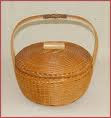 meshizaru 飯笊 (めしざる) basket for rice
meshizaru 飯笊 (めしざる) basket for rice
..... meshikago 飯籠(めしかご)
Mostly of woven bamboo, which has some ability to keep the rice from getting bad in summer.
Before putting the rice in the basket, a towel is spread to prevent the rice grains from getting squeezed in the holes of the basket.
kigo for all summer
 - quote
jikirou 食籠 jikiroo, jikiro
- quote
jikirou 食籠 jikiroo, jikiro
A lidded food container,
usually layered and lacquered with decorations of sunken gold *chinkin 沈金, carved lacquer *choushitsu 彫漆, mother-of-pearl inlay *raden 螺鈿, or metal leaf decoration, haku-e 箔絵, or sometimes of plain black lacquer, woven bamboo, or pottery. Round, quadrilateral hexagonal, octagonal and circular flower shapes are common.
Made in Yuan and Ming period China and in the Ryuukyuu 琉球 (now Okinawa prefecture), jikirou have been imported to Japan since the Kamakura period. They were later used as sweets containers at tea ceremonies.
A common type is the
juubako 重箱 (tiered food box) usually covered with *makie 蒔絵 and consisting of two, three, five or more tiers to store cooked rice, stewed dished, fish, or raw vegetables separately. In the Edo period juubako were common at picnics, and used with sagejuu 提重 (a picnic box holding various food and beverage containers in a light and compact form). The upper classes had highly decorated lacquer boxes while the lower classes had plain wood or unadorned lacquered grounds.
- source : Jaanus
. kago 籠 / 篭 / かご basket, baskets of all kinds .
.................................................................................
 ohachi-ire 飯櫃入 (おはちいれ) container to keep the rice warm
ohachi-ire 飯櫃入 (おはちいれ) container to keep the rice warm
(word used in Kanto)
hitsuire 櫃入れ(ひついれ)(word used in Kansai)
ohachibuton 飯櫃蒲団(おはちぶとん)quilt to cover it
ohachifugo 飯櫃畚(おはちふご)straw mat to cover it
A container made from straw with a lid. The rice containder with the cooked rice (komebitsu) was put it here to keep the rice warm for the next meal.
kigo for all winter
飯櫃入渋光りとも煤光りとも
ohachi-ire shibuhikari to mo susuhikari to mo
warmer for cooked rice -
shines of incrustations
shines of soot
Takahama Kyoshi 高浜虚子
:::::::::::::::::::::::::::::::::::::::::::::::::::::::::::::::::::::::::::::::::::::::::::::::::::::
Dishes with mostly rice
Bibimba, Korean rice dish
Koreanisches Reisgericht
Chaahan, fried rice
gebratener Reis, chinesische Art
Chazuke
Schale Reis mit Beilagen und grünem Tee übergossen
Chikin raisu, chicken rice
Huhn auf Reis
Donburi
Schale mit gekochtem Reis und Beilagen
Doria
Reiseintopf mit Fisch oder Hühnerfleisch
Italian food イタリアン料理 Spaghetti, Pizza, Pasta, Doria, Pesto
Gomoku gohan (kayaku gohan)
Reis mit aufgeletem Gemüse und Fischstücken
Hayashi raisu
Haschee auf Reis
Karee raisu, curry rice
Curryreis
Kuppa, Korean rice soup
Koreanische Reissuppe
Makunouchi bentoo
Lunchpaket „zwischen den Akten“
Meshi, gohan, white cooked rice
Weißer Reis
Nattokakegohan
Reis mit fermentierten Natto-Bohnen
Ochazuke
Schale Reis mit grünem Tee übergossen
Ohagi
Mochireis-Klößchen, mit Anko bedeckt
Okayu, kayu, simple rice soup
Einfache Reissuppe
Okowa
Mochi-Klebreis mit roten Bohnen
Ojiya, thick rice soup
Dicke Reissuppe
Omuraisu, omlet with rice
Omelett mit Reis
Onigiri
Reiskloß, Reisball
Pirafu
Pilaf, gebratener Reis
Takikomigohan, rice cooked with further ingredients
Reis gekocht mit weiteren Zutaten
Tamagokakegohan, rice with a raw egg
„Reis mit rohem Ei“
Zoosui, rice soup with other ingredients
Reissuppe mit weiteren Zutaten
:::::::::::::::::::::::::::::::::::::::::::::::::::::::::::::::::::::::::::::::::::::::::::::::::::::
 cooking rice in Japan
cooking rice in Japan
はじめちょろちょろなかぱっぱ 赤子泣いても蓋とるな
hajime choro-choro, naka pappa,
akago naitemo futa toru na
First use low heat, then turn it up in the middle
and never take off the lid even if your baby cries.
Anfangs
choro-choro, langsam anheizen bis es Blasen gibt und man das Blubbern hört, dann kräftig weiterkochen, bis das Wasser papp-pa zischt.
Und auf keinen Fall den Deckel abheben, selbst wenn die Kinder vor Hunger weinen.
choro
The first slow heat gives the grains time to soak up water
choro-choro. When they are full of water they can be cooked much faster
papp-pa. And after cooking, keep it standing for a while (even if the children are hungry).
Auch die Reihenfolge in der Familie beim Reisessen war festgelegt.
Even the order of eating rice in the family was given.
First the children.
Then the menfolk, starting with the eldest.
Next the mother-in-law and other in-law family members.
Finally the daughter in law.
:::::::::::::::::::::::::::::::::::::::::::::::::::::::::::::::::::::::::::::::::::::::::::::::::::::
梅雨湿りカレーライスを食べにけり
tsuyu shimeri karee raisu o tabe ni keri
humid rainy season ...
I go out to eat some
curry rice
Wakimoto Maki 脇本 眞樹(塾長)
月曜日, 6月 29, 2009
http://333751044.blogspot.com/2009/06/blog-post_3891.html
:::::::::::::::::::::::::::::::::::::::::::::::::::::::::::::::::::::::::::::::::::::::::::::::::::::

kinako musubi "きな粉むすび" rice balls with bean flour
似合はしや豆の粉飯に桜狩り
niawashi ya mame no ko meshi ni sakura-gari
so fitting -
bean-flour rice balls
while blossom hunting
Tr. Barnhill
Written in 1690 元禄3年
While visiting Iga Ueno.
mame no ko meshi is cooked rice sprinkled with kinako bean powder (kinako meshi きな粉飯), which can be formed to
musubi balls. This is simple but nurrishing food for the very poor.
sakura-gari is an expression referring to the elegant cherry blossom parties of the court of the Heian period. The normal word would be
hanami.
Here Basho contrasts the simple food with a free enjoyment of blossoms, just right for the haikai friends in Ueno.
.............................................................................

seri gohan 芹の飯 cooked rice with dropwort
我がためか鶴食み残す芹の飯
waga tame ka tsuru hami-nokosu seri no meshi
just for me -
the crane left over some
rice with dropwort
A disciple from Iga brought this dish to his master.
Ishikawa Senten 石川山店
dates unknown.
He was the younger brother of Ishikawa Hokkon 北鯤.
One of his hokku is in Sarumino.
1683. Basho is reminded of a a line in the poem by the Chinese poet Du Fu (Tu Fu), imagining the rice gruel at a shop in Seidei town. He is also comparing his disciple Senten to a crane, which likes dropwort very much.
Senten spared some of his own rice and gave it to him.
飯には煮る青泥坊底の芹
meshi ni wa niru Seidei bootei no seri
For cooking rice
dropwort picked at the embankment
of Seidei pond are best.
Seidei 青泥 was a town near the capital of Cho-an 長安, China.
is it for me
the crane leaves rice with parsley
for me to eat
Tr. Reichhold
MORE
Hokku about food and rice dishes by
. Matsuo Basho 松尾芭蕉 - Archives of the WKD .
. Japanese parcely 芹 seri, dropwort .
Oenanthe javanica
kigo for spring
愛汝玉山草堂靜,高秋爽氣相鮮新。
有時自發鐘磬響,落日更見漁樵人。
盤剝白鴉谷口栗,飯煮青泥坊底芹。
何為西莊王給事,柴門空閉鎖松筠。
Poem by Du Fu.
:::::::::::::::::::::::::::::::::::::::::::::::::::::::::::::::::::::::::::::::::::::::::::::::::::::
NEXT
Types of Japanese Rice .. 米 kome, mai
. WASHOKU
Favorite Rice Dishes from Edo .
My photos with RICE !
Traditional Folk Toys : Rice and Rice straw dolls
 "Planting rice"
"Planting rice" Ohno Bakufu (1888-1976)
source : facebook
:::::::::::::::::::::::::::::::::::::::::::::::::::::::::::::::::::::::::::::::::::::::::::::::::::::::::::::::::::::::::::
. Fertility rites - praying for a good harvest .
WASHOKU : INGREDIENTS
For more words with RICE as food, check the main
WASHOKU ... Japanese Food SAIJIKI
[ . BACK to DARUMA MUSEUM TOP . ]
[ . BACK to WORLDKIGO . TOP . ]
:::::::::::::::::::::::::::::::::::::::::::::::::::::::::::::::::::::::::::::::::::::::::::::::::::::::::::::::::::::::::::


